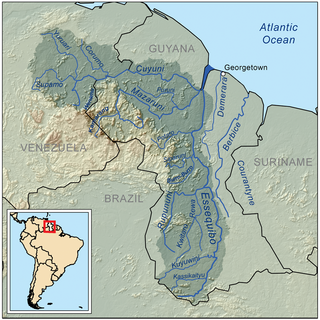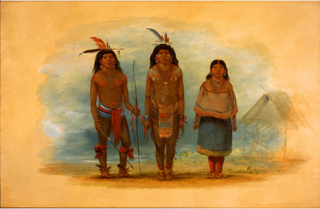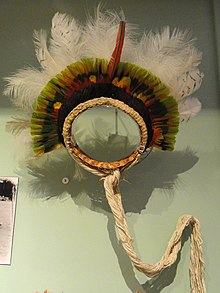
The Cariban languages are a family of languages indigenous to northeastern South America. They are widespread across northernmost South America, from the mouth of the Amazon River to the Colombian Andes, and they are also spoken in small pockets of central Brazil. The languages of the Cariban family are relatively closely related. There are about three dozen, but most are spoken only by a few hundred people. Macushi is the only language among them with numerous speakers, estimated at 30,000. The Cariban family is well known among linguists partly because one language in the family—Hixkaryana—has a default word order of object–verb–subject. Prior to their discovery of this, linguists believed that this order did not exist in any spoken natural language.

The Rupununi is a region in the south-west of Guyana, bordering the Brazilian Amazon. The Rupununi river, also known by the local indigenous peoples as Raponani, flows through the Rupununi region. The name Rupununi originates from the word rapon in the Makushi language, in which it means the black-bellied whistling duck found along the river.

The Warao are an indigenous Amerindian people inhabiting northeastern Venezuela, Trinidad and Tobago, Guyana, and Suriname. Alternate common spellings of Warao are Waroa, Guarauno, Guarao, and Warrau. The term Warao translates as "the boat people", after the Warao's lifelong and intimate connection to the water. Most Warao inhabit Venezuela's Orinoco Delta region, with smaller numbers in neighbouring Guyana, Trinidad and Tobago, and Suriname. With a population of 49,271 people in Venezuela during the 2011 census, they were the second largest indigenous group after the Wayuu people. They speak an agglutinative language, Warao.

The Macushi are an indigenous people living in the borderlands of southern Guyana, northern Brazil in the state of Roraima, and in an eastern part of Venezuela.

The Wapishana or Wapichan are an indigenous group found in the Roraima area of northern Brazil and southern Guyana.

The Kalina, also known as the Caribs or mainland Caribs and by several other names, are an Indigenous people native to the northern coastal areas of South America. Today, the Kalina live largely in villages on the rivers and coasts of Venezuela, Guyana, Suriname, French Guiana, and Brazil. They speak a Cariban language known as Carib. They may be related to the Island Caribs of the Caribbean, though their languages are unrelated.

The Patamona are an Amerindian people native to the Pakaraima Mountains of Guyana and northern Brazil. They speak a Cariban language, Kapóng, and have often been referred to interchangeably as Akawaio or Ingariko. Patamona are considered a sub-group of Kapon people.

The Akawaio are an indigenous people who live in Roraima (Brazil), Guyana, and Venezuela. They are one of several closely related peoples called Ingarikó and Kapon. The Akawaio language is used by 5,000 to 6,000 speakers.

The Kalapalo are an indigenous people of Brazil. They are one of seventeen tribal groups who inhabit the Xingu National Park in the Upper Xingu River region of the state of Mato Grosso. They speak the Amonap language, a Cariban language, and one of four spoken languages in the area. They have a population of 569 as of 2010.
The Kassikaityu River is a tributary of the Essequibo River of Guyana.
The North Rupununi District in located in south-west Guyana consisting of a mixture of forest, savannah and wetlands ecosystems and is considered one of the most diverse areas in South America. Located on the eastern margin of the larger savannah system which extends into Brazil and is separated by the Ireng and Takutu rivers that come together to form the Rio Branco. The Guyana Rupununi system is divided into the North and South Rupununi by the Kanuku Mountains.
The Kanashen Community Owned Conservation (COCA) is Guyana's first community-owned area that is legally protected; it is primarily inhabited by the Wai-Wai indigenous group.
Wowetta is an indigenous village in the Upper Takutu-Upper Essequibo Region in Guyana. The village is mainly inhabited by Macushi people.
Waiwai is a Cariban language of northern Brazil, with a couple hundred speakers across the border in southern Guyana and Suriname.
Macushi is an indigenous language of the Carib family spoken in Brazil, Guyana and Venezuela. It is also referred to as Makushi, Makusi, Macuxi, Macusi,Macussi,Teweya or Teueia. It is the most populous of the Cariban languages. According to Instituto Socioambiental, the Macushi population is at an estimated 43,192, with 33,603 in Brazil, 9,500 in Guyana and 89 in Venezuela. In Brazil, the Macushi populations are located around northeastern Roraima, Rio Branco, Contingo, Quino, Pium and Mau rivers. Macuxi speakers in Brazil, however, are only estimated at 15,000.

Indigenous Guyanese, Native Guyanese or Amerindian Guyanese are Guyanese people who are of indigenous ancestry. They comprise approximately 9.16% of Guyana's population. Amerindians are credited with the invention of the canoe, as well as Cassava-based dishes and Guyanese pepperpot, the national dish of Guyana. Amerindian languages have also been incorporated in the lexicon of Guyanese Creole.
Audrey Joan Butt Colson, is a social anthropologist with a particular interest in the Amerindian peoples of Guyana, Brazil and Venezuela. She was, together with Peter Rivière, one of the pioneers of Amazonian anthropology at the University of Oxford.

Mount Roraima National Park is a national park in the state of Roraima, northern Brazil.
The Pidjanan languages are a subgroup of Arawakan languages of northern South America.

The Taruma are an indigenous people found in the northern Brazil, southern Guyana, and southern Suriname. They used to speak Taruma which is considered critically endangered. The Taruma in Suriname have merged with the Tiriyó, in Brazil they merged with the Wai-wai. The Wapishana village of Maruranau in Guyana still recognises the tribe.














